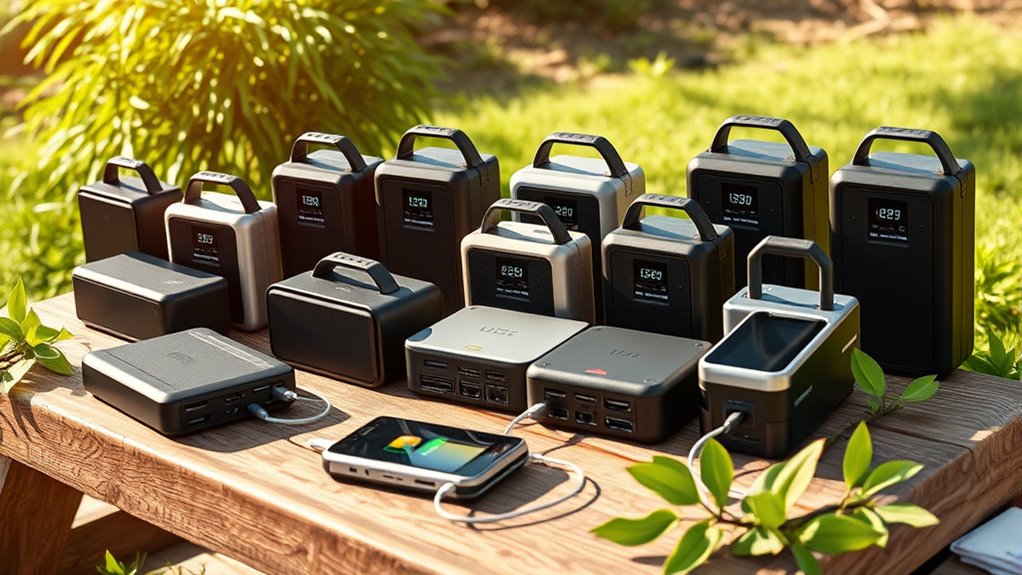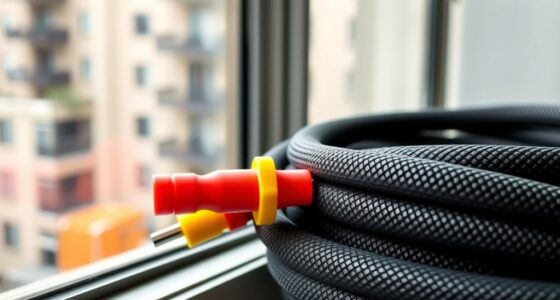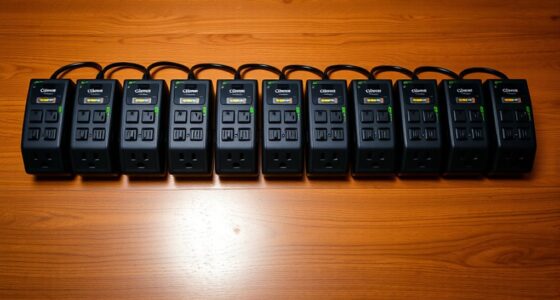If you’re looking for reliable portable power stations, I recommend checking out options like the Jackery Explorer 300, EF ECOFLOW DELTA 2, and Anker 521. They offer a good mix of capacity, portability, and versatile outlets for devices on the go. Smaller models are perfect for camping or emergencies, while larger ones support more demanding needs. Keep exploring to get all the details and find the best fit for your adventures.
Key Takeaways
- Compact portable power stations vary from lightweight power banks to larger units, offering diverse capacities and features for on-the-go use.
- They support multiple device types with various output ports, including AC, USB-C, USB-A, and car sockets, ensuring versatile charging options.
- Many models feature fast recharging, solar compatibility, and expandability, making them suitable for outdoor adventures and emergency backup.
- Durability, long battery lifespan, and user-friendly designs make these power stations reliable for extended or off-grid use.
- Consider size, weight, power capacity, and specific features like app control or pure sine wave inverters to match your portable power needs.
Jackery Portable Power Station Explorer 300

The Jackery Portable Power Station Explorer 300 is an ideal choice for outdoor enthusiasts who need reliable, portable energy on the go. With a 293Wh lithium-ion battery, it delivers a steady 300W power through two Pure Sine Wave AC outlets, perfect for sensitive electronics. Weighing just 7.1 pounds, it’s lightweight and easy to carry for camping, hiking, or road trips. It recharges quickly—80% in two hours via wall outlet or through a 60W PD USB-C port—and can also be charged with solar panels. Its multiple outlets allow you to power up to six devices simultaneously, making it versatile and dependable in off-grid situations.
Best For: outdoor enthusiasts and travelers seeking a lightweight, reliable portable power source for camping, hiking, and off-grid adventures.
Pros:
- Compact and lightweight design (7.1 pounds) for easy portability
- Fast recharging options, including 80% in 2 hours via wall outlet and solar compatibility
- Multiple outlets (AC, USB-C, USB-A, DC) allowing simultaneous charging of up to six devices
Cons:
- Limited 293Wh capacity may not support high-power devices for extended periods
- Solar panel sold separately, increasing overall cost for solar recharging
- No built-in wireless charging feature for added convenience
Portable Power Station 99.9Wh Power Bank

If you’re looking for a compact power solution that’s airline-compliant and perfect for outdoor adventures, the Portable Power Station 99.9Wh Power Bank fits the bill. Its high-capacity lithium-ion battery can power multiple devices for hours, making it ideal for camping, travel, or emergencies. Weighing just 1.65 lbs and measuring 6.5 x 3.2 x 1.9 inches, it’s incredibly portable. It features six versatile ports—including AC, Type-C, and USB-C—supporting fast charging and simultaneous device use. Built with durable materials and equipped with safety features, it offers reliable, long-term performance. Plus, its solar compatibility and handy display make outdoor living even easier.
Best For: outdoor enthusiasts, travelers, and emergency preparedness individuals seeking a lightweight, reliable power source for multiple devices on the go.
Pros:
- Compact and lightweight design easily portable for camping, travel, and emergencies.
- Supports fast charging with multiple ports, including AC, Type-C, and USB-C, for simultaneous device use.
- Durable construction with safety features like over-protection and alarm system, ensuring reliable long-term performance.
Cons:
- Solar charging is slow and primarily suitable for emergency backup rather than regular use.
- Limited maximum capacity of 99.9Wh may not power larger or high-energy devices for extended periods.
- Battery cycle life, while exceeding 1000 cycles, may require eventual replacement for prolonged use.
EF ECOFLOW Portable Power Station DELTA 2 (1024Wh, LiFePO4 Battery)
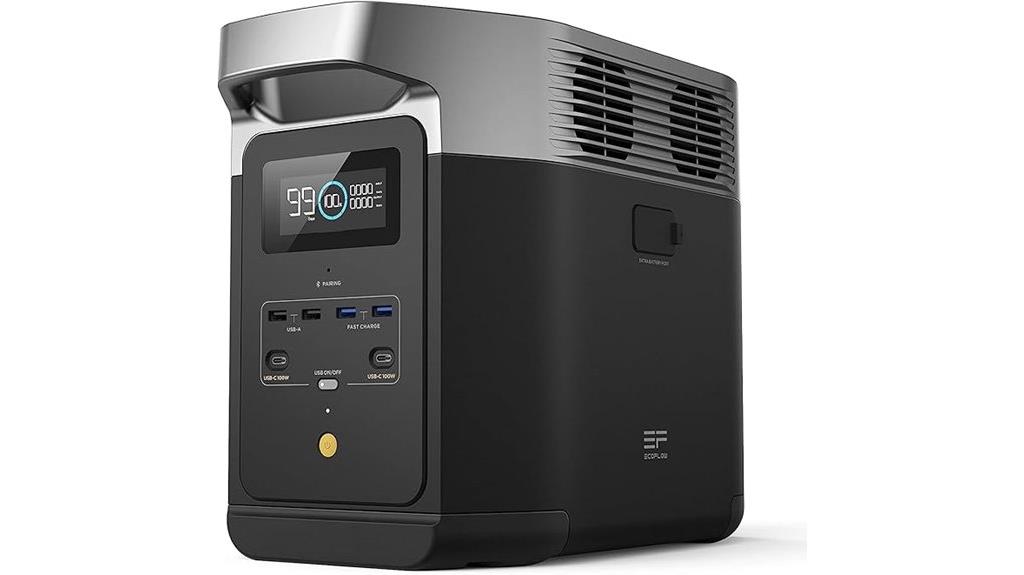
For campers, RV travelers, and anyone off-grid, the EF ECOFLOW DELTA 2 stands out with its impressive 1024Wh LiFePO4 battery that’s not only powerful but also expandable, allowing you to increase capacity from 1kWh to 3kWh by adding extra batteries. It can power most household appliances with 1800W AC and 100W USB-C outputs, making it versatile for various devices. Recharging is quick—80% in 50 minutes via AC—and supports solar input up to 500W, perfect for eco-friendly off-grid use. Built with durable LiFePO4 chemistry, it offers over 3,000 charge cycles, ensuring long-lasting, reliable performance.
Best For: campers, RV travelers, and off-grid users seeking a reliable, expandable portable power solution for a variety of appliances.
Pros:
- Powerful 1024Wh LiFePO4 battery with over 3,000 charge cycles for long-lasting use
- Expandable capacity from 1kWh to 3kWh with additional batteries for greater flexibility
- Fast recharge time of 80% in 50 minutes and supports solar input up to 500W for eco-friendly off-grid charging
Cons:
- Limited to 1800W AC output, which may not power very high-demand appliances
- Heavier and bulkier compared to smaller portable chargers, potentially less convenient for some users
- Requires additional batteries for maximum capacity, adding to overall cost and setup complexity
Anker 521 Portable Power Station with LiFePO4 Battery (256Wh)

Designed for outdoor enthusiasts and emergency preppers alike, the Anker 521 Portable Power Station stands out with its durable LiFePO4 battery that guarantees long-lasting performance. With a 256Wh capacity and 300W rated power (peak 600W), it can charge laptops, phones, CPAPs, and small appliances reliably. Its multiple outputs—including AC outlets, USB-C PD, USB-A, and a car socket—offer versatile connectivity. Weighing just 8.2 pounds, it’s compact and easy to carry. Supporting both solar and battery power, it features fast charging, safety systems, and a long lifespan of up to 10 years, making it a dependable off-grid power solution.
Best For: outdoor enthusiasts, campers, and emergency preppers seeking a reliable, portable power source for charging devices and small appliances off-grid.
Pros:
- Lightweight and compact design weighing only 8.2 pounds for easy portability
- Long-lasting LiFePO4 battery with a 10-year lifespan and multiple safety features
- Versatile output options including AC outlets, USB-C PD, USB-A, and car socket for various devices
Cons:
- Higher price point compared to similar portable power stations with lower capacity
- Limited wattage output may restrict use with larger appliances or high-demand devices
- Charging from vehicle inverters can be hindered by wiring and voltage drop issues
Jackery Explorer 1000 v2 Portable Power Station
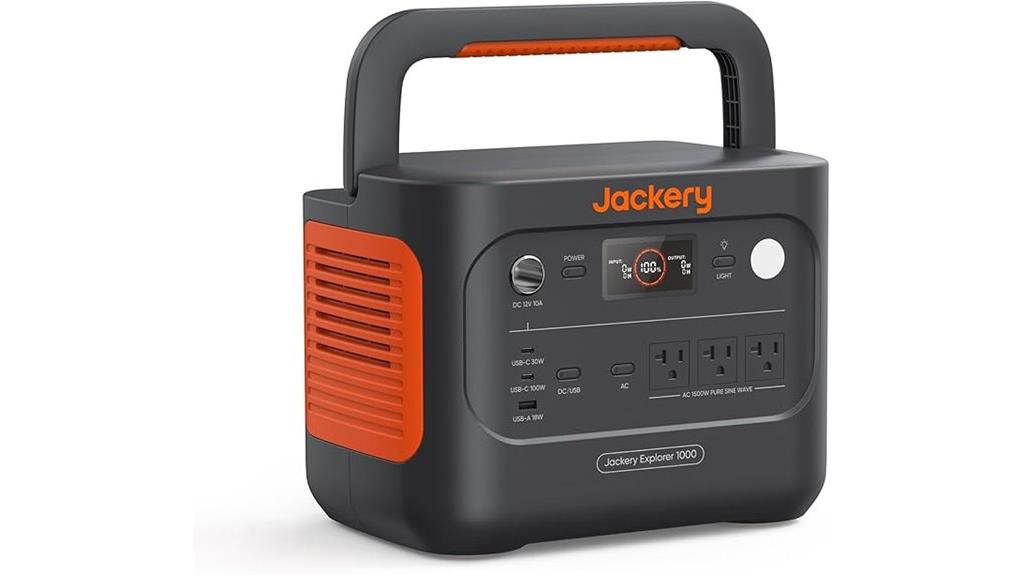
The Jackery Explorer 1000 v2 stands out as a top choice for outdoor enthusiasts and emergency preppers who need reliable, high-capacity power on the go. With a 1500W AC output and a 1070Wh LiFePO4 battery, it can run appliances like fridges, AC units, and electric pots. It features multiple ports, including USB-C, USB-A, a car port, and three AC outlets, with fast PD 100W charging. Weighing just 23.8 lbs with a foldable handle, it’s perfect for camping or emergencies. Fast charging from 0 to 100% takes about an hour via the app, ensuring quick, safe power whenever you need it.
Best For: outdoor enthusiasts, emergency preppers, and anyone needing reliable, high-capacity portable power for camping, road trips, or power outages.
Pros:
- High power output of 1500W AC with a 3000W surge peak supports multiple large appliances simultaneously.
- Fast charging capability from 0 to 100% in approximately one hour via the app, ensuring quick power replenishment.
- Durable LiFePO4 battery offers over 4,000 charge cycles and longevity exceeding 10 years, maintaining over 70% capacity.
Cons:
- Compatible only with Jackery solar panels for solar charging, limiting flexibility with other brands.
- Cannot be delivered to PO boxes, only to physical addresses.
- Solar panel not included in the package, requiring separate purchase.
Anker Portable Power Station SOLIX C300, 288Wh LiFePO4 Battery
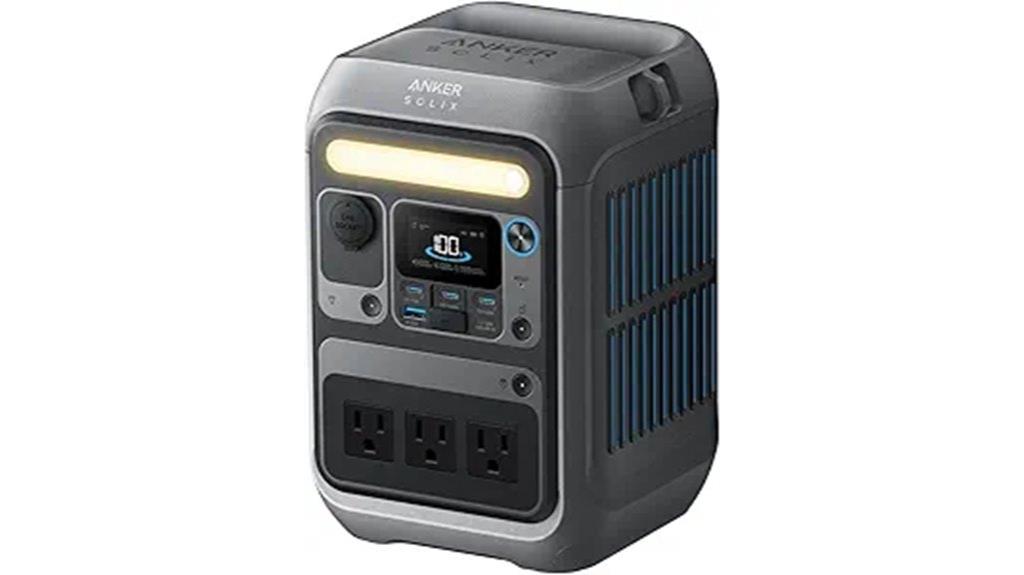
If you need a portable power station that combines high capacity with lightweight convenience, the Anker SOLIX C300 is an excellent choice. It features a 288Wh LiFePO4 battery that delivers 300W continuous power and 600W surge, perfect for camping, travel, or emergencies. Its compact design is 15% smaller than similar models, making it easy to carry. With 8 versatile charging ports—including AC outlets, USB-C, and car socket—you can power multiple devices simultaneously. Recharging is quick, reaching 80% in just 50 minutes via wall outlet, and it supports solar panel charging. Built for durability, it offers a 10-year lifespan and safety features like impact resistance and temperature control.
Best For: outdoor enthusiasts, travelers, and emergency preparedness individuals seeking a compact, reliable, and versatile portable power station.
Pros:
- High capacity with 288Wh LiFePO4 battery ensuring long-lasting power and durability for extensive use.
- Multiple charging options including AC, USB-C, and car socket allow for simultaneous device charging.
- Compact, lightweight design at 15% smaller than similar models makes it highly portable and travel-friendly.
Cons:
- Not compatible with certain solar panels like Anker SOLIX PS30, PS200, and PS400, limiting recharging options.
- Maximum continuous power of 300W may be insufficient for high-power appliances.
- Longer recharging time when not using wall outlets, especially with lower wattage solar panels.
MARBERO Portable Power Station 88Wh Lithium Battery Solar Generator
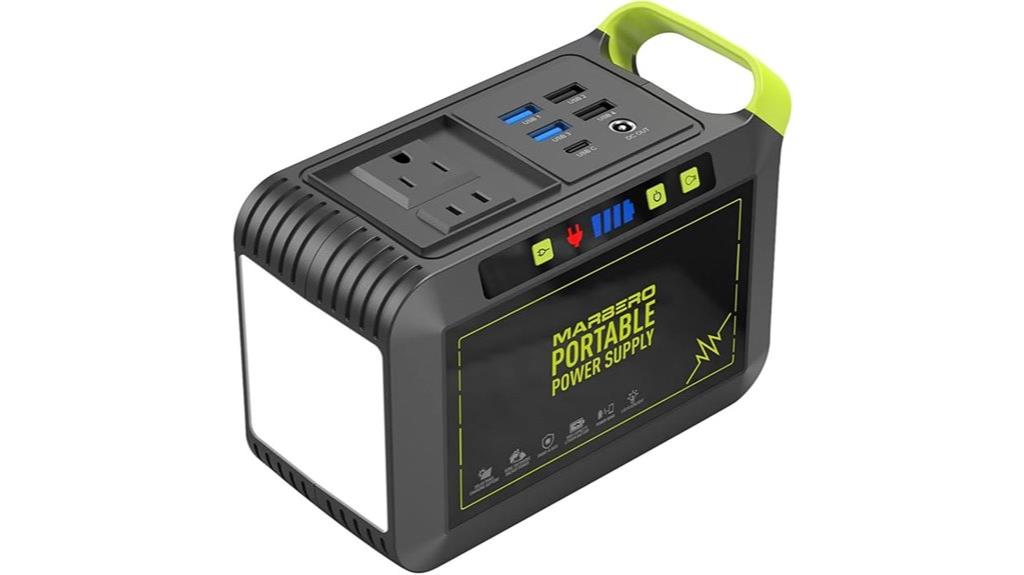
For anyone seeking a lightweight yet versatile power source, the MARBERO Portable Power Station 88Wh stands out with its compact size and multiple output options. Measuring just 6.5 x 4.6 x 3.1 inches and weighing only 3.2 pounds, it’s easy to carry on outdoor adventures or during emergencies. It features 8 output ports, including AC, USB, USB-C PD, and car DC, supporting simultaneous device charging. Its lithium-ion battery offers up to 90 hours of power for small devices, with fast recharge times of around 2 hours. The built-in LED flashlight and safety features like BMS make it a reliable, practical choice for camping, power outages, or on-the-go use.
Best For: outdoor enthusiasts, emergency preparedness, and home users seeking a portable, versatile power solution for charging multiple devices on the go.
Pros:
- Compact, lightweight design (only 3.2 lbs) with ergonomic handle for easy portability
- Supports multiple devices simultaneously via 8 output ports including AC, USB, USB-C PD, and car DC
- Fast charging capability (0 to 80% in approximately 2 hours) and built-in LED flashlight with multiple modes
Cons:
- Some users report reduced battery performance or device shutdowns after extended use
- Limited capacity of 88Wh may not be sufficient for larger or high-power devices over long periods
- Durability concerns over long-term usage and battery lifespan, with occasional issues noted by some users
Portable Power Station 300W with Solar Generator and LED Flashlight

A portable power station with a 300W capacity, solar compatibility, and built-in LED flashlight is an ideal choice for outdoor enthusiasts and emergency preppers alike. Its 296Wh battery supports multiple devices simultaneously, including phones, laptops, and small appliances, with a pure sine wave AC outlet and USB-C PD port. The 360° camping light with SOS and strobe modes provides reliable illumination, while the lightweight design and built-in handle make it easy to carry. Recharge it in about 6 hours via USB-C or solar panels (80-120W). Durable and safe, this station offers dependable power and lighting for camping, outages, or off-grid adventures.
Best For: outdoor enthusiasts, emergency preppers, and travelers seeking a reliable, portable power source with versatile lighting and device compatibility.
Pros:
- Supports multiple devices simultaneously with AC, USB-C, USB-A, and DC ports
- Features 360° camping lighting with SOS and strobe modes for emergency use
- Lightweight and portable design with a built-in handle for easy transport
Cons:
- Limited 296Wh capacity may require careful device management during extended outages
- Recharge time of approximately 6 hours, which may be longer compared to some fast-charging options
- Slightly higher price point compared to basic power banks, especially without discounts
Portable Power Station, 300W Lithium Battery Generator

The BailiBatt Portable Power Station stands out as an excellent choice for outdoor enthusiasts and emergency preppers who need reliable, silent power on the go. Weighing just 5.9 pounds and made from durable ABS, it’s highly portable. With a 266Wh capacity, it powers laptops, phones, small appliances, and even medical devices like CPAP machines for several nights. Equipped with multiple ports—including USB-C, USB-A, DC, and a 300W pure sine wave AC outlet—it handles various electronics simultaneously. Its fast recharging, safety features, and built-in flashlight make it perfect for camping, travel, or emergency backup, offering dependable power wherever you need it.
Best For: outdoor enthusiasts, campers, and emergency preppers seeking reliable, portable power for electronics and small appliances during outdoor adventures or power outages.
Pros:
- Lightweight and highly portable at only 5.9 pounds, easy to carry and pack.
- Multiple output options including AC, USB-C, USB-A, and DC for versatile device charging.
- Quiet operation with fast recharging and built-in safety features for reliable use in various scenarios.
Cons:
- Limited 266Wh capacity may not power larger appliances or devices for extended periods.
- Maximum output of 300W restricts use to smaller electronics and appliances.
- Requires periodic recharging every 1–2 months to maintain battery health, which may be inconvenient for infrequent users.
Portable Power Station 56000mAh, 179.2Wh LiFePO4 Battery Backup

If you need a lightweight, reliable power source for outdoor adventures or emergency situations, the Portable Power Station 56000mAh, 179.2Wh LiFePO4 Battery Backup stands out. Weighing just 6.2 pounds and smaller than a toaster, it’s perfect for camping, RV trips, or home backup. With 7 ports—including fast-charging USB-C, AC outlets, and DC options—it supports laptops, phones, lights, and small appliances rated under 300W. Its durable ABS build and compact design make it easy to carry. The LiFePO4 battery offers over 3500 cycles, enhanced safety, and longevity. Plus, the built-in LED flashlight adds extra utility during power outages or nighttime outdoor activities.
Best For: outdoor enthusiasts, emergency preparedness, and anyone needing a portable, reliable power backup for small devices and appliances under 300W.
Pros:
- Lightweight and compact design weighing only 6.2 lbs, making it highly portable for outdoor and emergency use
- Supports multiple devices simultaneously with 7 versatile ports including fast-charging USB-C and AC outlets
- Equipped with durable LiFePO4 batteries offering over 3500 charge cycles and enhanced safety features
Cons:
- Limited battery capacity of 179.2Wh, which may require recharge during extended use or multiple devices
- Non-readable daylight screen and calibration issues can make monitoring power levels less convenient
- Car charger is sold separately, and some users experienced initial charging failures or limited instructions
Jackery Explorer 240 Portable Power Station
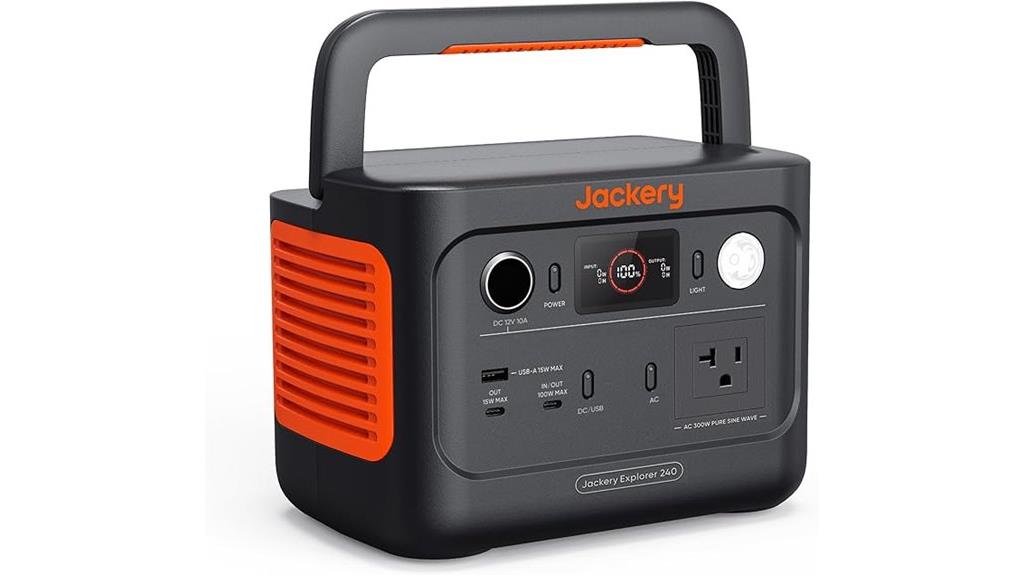
For outdoor enthusiasts and emergency preppers alike, the Jackery Explorer 240 Portable Power Station stands out as an ideal choice thanks to its compact size and reliable power output. Weighing just 7.7 pounds and measuring 9.1 x 6 x 6.6 inches, it’s easy to carry for camping, RV trips, or emergency backup. Its durable LiFePO4 battery offers a 10-year lifespan with over 3,000 charge cycles. The device features a clear display, multiple ports—including USB-C, USB-A, and a 300W AC outlet—and can recharge quickly via wall outlet, solar, or app control. Safety-certified and solar-ready, it’s a versatile, dependable power solution on the go.
Best For: outdoor enthusiasts, emergency preppers, and travelers seeking a portable, reliable power source for camping, RV trips, or backup power.
Pros:
- Compact and lightweight design for easy portability
- Fast recharging options via wall outlet, solar panels, or app control
- Multiple ports including USB-C, USB-A, and AC for versatile device charging
Cons:
- Lack of included USB-C solar charging adapter
- USB-C connector’s durability may be questionable over time
- Basic app functionality with limited features and difficulty adjusting WiFi/Bluetooth settings
DABBSSON 2000L Solar Generator (2025 Model), 2048Wh LiFePO4 Power Station
https://m.media-amazon.com/images/I/71RQvrAU8cL._AC_SX679_.jpg
Designed for those who need dependable power on the go, the DABBSSON 2000L Solar Generator (2025 Model) stands out with its impressive 2048Wh LiFePO4 battery and high-capacity output. Its compact, lightweight design—just 41 pounds with built-in handles—makes it easy to carry, while fire-resistant casing guarantees safety. With 2200W rated power and six AC outlets, it can run multiple high-wattage devices simultaneously. Fast charging via AC, solar, or car, plus remote monitoring through the app, offers convenience and flexibility. Reliable and user-friendly, it’s perfect for camping, home backup, or outdoor adventures, providing peace of mind wherever you go.
Best For: outdoor enthusiasts, campers, and homeowners seeking a reliable, portable power solution for emergency backup or off-grid adventures.
Pros:
- Ultra-compact and lightweight design with sturdy, fire-resistant casing for easy portability and safety.
- High-capacity 2048Wh LiFePO4 battery with over 4000 charge cycles, ensuring long-term performance.
- Multiple charging options including fast AC, solar, and vehicle input, plus remote monitoring via app for convenience.
Cons:
- Slightly heavier than some portable units at 41 pounds, which may impact extremely lightweight carry.
- The high capacity and multiple outlets may lead to higher initial cost compared to smaller or simpler models.
- Requires a Wi-Fi or Bluetooth connection for app management, which may not be ideal in remote areas with poor connectivity.
OUPES Mega 1 Portable Power Station (2000W)

The OUPES Mega 1 Portable Power Station stands out with its massive 1024Wh LiFePO4 battery, which can be expanded to 5120Wh using the B2 extra battery. It delivers a robust 2000W continuous AC output, peaking at 4500W, making it perfect for running high-watt appliances like refrigerators and CPAP machines. With 13 outlets—including USB-C, USB-A, DC, and standard AC—it offers versatile connectivity. Charging is flexible, supporting solar, AC, car, or hybrid inputs up to 2200W, with fast and slow options to balance speed and battery health. Its WiFi/Bluetooth app allows real-time monitoring, and a 20ms UPS switch keeps your devices powered during outages.
Best For: campers, RV owners, and homeowners seeking reliable, high-capacity portable power with expandability and versatile charging options.
Pros:
- Large 1024Wh LiFePO4 battery with expandable capacity up to 5120Wh for extended use
- 2000W continuous AC output suitable for high-watt appliances like refrigerators and CPAP machines
- Multiple charging methods including fast and slow options, with real-time monitoring via app
Cons:
- Heavier and potentially less portable due to high capacity and multiple batteries
- Higher price point compared to smaller or less expandable power stations
- Limited to 2200W input capacity, which may slow down charging when using multiple sources
Portable Power Station 300W (Peak 600W) with Solar Generator and Lithium Battery

If you’re seeking a portable power station that balances power and portability, the 300W (peak 600W) model with a lithium battery is an excellent choice. It offers a 230.88Wh capacity, supporting devices like laptops, phones, lights, and small appliances below 330W. Weighing just 7.3 pounds and measuring roughly 9.6 x 6.7 x 7 inches, it’s easy to carry on camping trips, outdoor adventures, or as a home backup. With six outputs, including AC, USB-C PD 60W, and car port, plus three recharging options—AC, solar, and car—it’s versatile, reliable, and perfect for on-the-go power needs.
Best For: outdoor enthusiasts, travelers, and homeowners seeking a portable, reliable power source for small appliances and electronic devices during camping, emergencies, or outdoor activities.
Pros:
- Compact and lightweight design weighing only 7.3 pounds for easy portability
- Multiple recharging options including AC, solar, and car input for versatile use
- Supports simultaneous charging of six devices with a variety of ports including USB-C PD 60W and AC outlet
Cons:
- Limited capacity of 230.88Wh may not power larger appliances for extended periods
- Supports devices below 330W, so high-wattage appliances are incompatible
- Price can vary among sellers, and some units may experience early defects requiring support or replacement
AFERIY P210 Portable Power Station (2400W, 2048Wh, LiFePO4 Battery)

For those seeking a powerful, long-lasting portable energy solution, the AFERIY P210 stands out with its massive 2048Wh LiFePO4 battery and 2400W continuous output. Its LiFePO4 chemistry guarantees safety, stability, and a 10-year lifespan with over 3,500 charge cycles, making it reliable for home backup, outdoor adventures, and off-grid use. The pure sine wave inverter delivers clean power for sensitive electronics, while multiple charging options—including AC, solar, and car—offer flexibility. Despite its high capacity, it’s portable at around 54 pounds, with user-friendly features like an LED display and remote control via the AFERIY app.
Best For: outdoor enthusiasts, homeowners seeking reliable backup power, and off-grid users needing a portable, long-lasting energy solution.
Pros:
- High-capacity 2048Wh LiFePO4 battery with a 10-year lifespan and over 3,500 charge cycles
- Multiple charging options including AC, solar, and car, with rapid charging capabilities
- Lightweight design at approximately 54 pounds with user-friendly features like an LED display and remote app control
Cons:
- Relatively heavy for some portable applications despite being lighter than comparable models
- Higher initial cost due to advanced battery technology and features
- Limited to 2400W continuous power output, which may not suffice for very high-power appliances
Factors to Consider When Choosing a Compact Portable Power Station
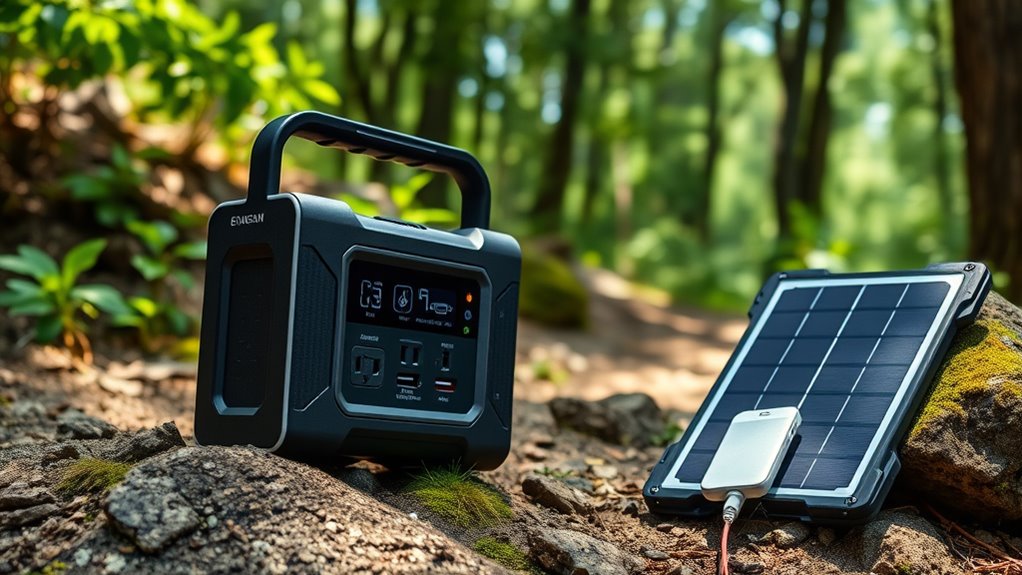
When choosing a portable power station, I consider factors like power capacity to match my needs, how easy it is to carry, and the variety of charging options available. I also look at battery life to guarantee it lasts through multiple uses and safety features to protect both the device and myself. Keep these points in mind to find a unit that’s reliable and fits your on-the-go lifestyle.
Power Capacity Needs
How do you determine the right capacity for a portable power station? First, add up the total watt-hours (Wh) needed to run your essential devices for your expected usage duration. Choose a power station with at least that capacity to guarantee it can handle your needs. Also, check the continuous output wattage (W) to confirm it can support your appliances without overloading. For high-wattage items like refrigerators or power tools, pick a model with a surge capacity that exceeds their startup wattage. Consider how long you’ll need power—larger capacities provide longer runtimes but tend to be heavier. Balancing your power needs with portability is key, so select a capacity that meets your typical usage without sacrificing too much convenience.
Portability and Weight
Choosing the right portable power station depends heavily on its weight and size, as these factors directly affect how easy it is to carry and set up. Lighter units are ideal for outdoor adventures like hiking and camping, where mobility is key. A compact design allows the device to fit easily into backpacks, vehicle trunks, or small storage spaces, making transportation effortless. Ergonomic handles and streamlined shapes enhance comfort and handling during movement and setup. Keep in mind, heavier models often have larger batteries and higher capacities but can cause fatigue during extended carries or frequent relocations. Finding the right balance between size and weight is vital—ensuring the power station is portable enough for your needs without sacrificing power or durability.
Charging Options Flexibility
A portable power station’s versatility hinges on its ability to recharge through multiple methods. I look for models supporting AC wall outlets, solar panels, and vehicle adapters to keep power flowing in any scenario. An MPPT charge controller boosts solar efficiency, extracting maximum energy from panels regardless of weather. Fast recharging features, like under two hours via AC or USB-C PD, minimize downtime and ensure quick readiness. Compatibility with various solar panel wattages and connector types offers added flexibility, letting me tailor renewable energy input. The ability to pass through charge while powering devices is also a game-changer, allowing simultaneous recharging and device operation. These options make a power station truly adaptable, ensuring reliable energy wherever I go, no matter the circumstances.
Battery Longevity & Life
When evaluating portable power stations, battery longevity is a key factor that can considerably impact your investment’s value. High-quality lithium-ion or LiFePO4 batteries typically offer 1,000 to over 3,500 charge cycles before noticeable capacity decline. LiFePO4 batteries generally last longer, supporting over 3,000 to 4,000 cycles, whereas traditional lithium-ion batteries usually last around 500 to 1,000 cycles. Several factors influence a battery’s lifespan, including temperature, charging speed, depth of discharge, and maintenance. Proper recharging practices, like avoiding full discharges and not overcharging, can prolong battery life and maintain capacity. Manufacturers often specify cycle counts and warranties, giving you a good idea of how long the battery will perform reliably over time.
Safety & Protection Features
Safety and protection features play a vital role in ensuring your portable power station operates reliably and securely. I look for units with advanced Battery Management Systems (BMS) that monitor voltage, current, and temperature, preventing overcharging, overdischarging, and overheating. Many models include pure sine wave inverters to deliver stable, clean power, protecting sensitive electronics from surges. Overload protection automatically shuts down the device if the power draw exceeds its capacity, safeguarding both the station and connected gadgets. Standard short circuit and over-current protections further reduce electrical hazards. Some units even feature fire-resistant casings, automatic shutoff timers, and alarms to alert me of abnormal conditions. These safety features give me peace of mind, ensuring safe and reliable operation wherever I go.
Device Compatibility
Choosing a portable power station that matches your device needs requires careful attention to its output ports and wattage ratings. First, guarantee it has the right ports—AC outlets for laptops, USB or USB-C for smartphones, and DC for other gadgets. Check the wattage ratings to make sure your devices can draw enough power, including surge capacity for high-wattage appliances. Support for fast charging protocols like Power Delivery (PD) is a plus, especially for quick-charging laptops and phones. Additionally, verify if the station is compatible with your planned recharging methods, such as solar panels, by confirming input wattage and connector types. Finally, prioritize devices with safety features like pure sine wave output and overload protection to keep your electronics safe and stable during use.
Frequently Asked Questions
How Long Do Portable Power Stations Typically Last on a Full Charge?
A portable power station usually lasts anywhere from 4 to 12 hours on a full charge, depending on what you’re powering and its capacity. I’ve found that smaller units work well for quick charges or small devices, while larger ones can handle multiple gadgets for longer periods. To get the most out of yours, always check its watt-hour rating and consider your power needs before heading out.
Can Portable Power Stations Power High-Wattage Appliances?
Yes, portable power stations can power high-wattage appliances, but it depends on their capacity and output. I always check the continuous wattage and surge capacity before plugging in anything like microwaves, hairdryers, or power tools. For those appliances, I prefer larger stations with higher watt-hour ratings and robust inverters. Always verify your device’s wattage doesn’t exceed the station’s limits to avoid overloads and damage.
Are Portable Power Stations Safe for Outdoor or Emergency Use?
Oh, absolutely—portable power stations are the superheroes of outdoor adventures and emergencies. They’re designed with safety in mind, with features like overload protection and surge regulation. Sure, you should follow the user manual and avoid misusing them, but honestly, they’re pretty reliable and safe for outdoor or emergency use. So go ahead, power up your devices confidently, and enjoy peace of mind when it matters most.
How Do Solar Panels Integrate With These Power Stations?
Solar panels connect easily with portable power stations, allowing me to recharge them using sunlight. I simply plug the panels into the station’s input port, and they start converting solar energy into usable power. This setup is perfect for outdoor adventures or emergencies, as it provides a renewable, quiet, and eco-friendly way to keep my devices charged without relying on grid power. It’s a smart, sustainable choice for on-the-go energy.
What Is the Typical Lifespan of a Portable Power Station’s Battery?
Think of a portable power station’s battery as a diligent garden that blooms with care. Typically, it lasts between 500 to 1,500 charge cycles, which translates to about 2-5 years of reliable use. With proper maintenance, it’s like nurturing that garden to flourish longer, ensuring your devices stay energized on every adventure. Keep an eye on performance, and your power station will serve you well through many journeys.
Conclusion
When choosing a compact portable power station, I know it can feel overwhelming—like finding a needle in a haystack. But with the right info, you’ll discover a trusty sidekick that keeps your devices powered up no matter where adventure takes you. These stations are truly game-changers, offering reliable energy on demand. Trust me, once you find your perfect match, you’ll wonder how you ever traveled without it—your ultimate power backup!
